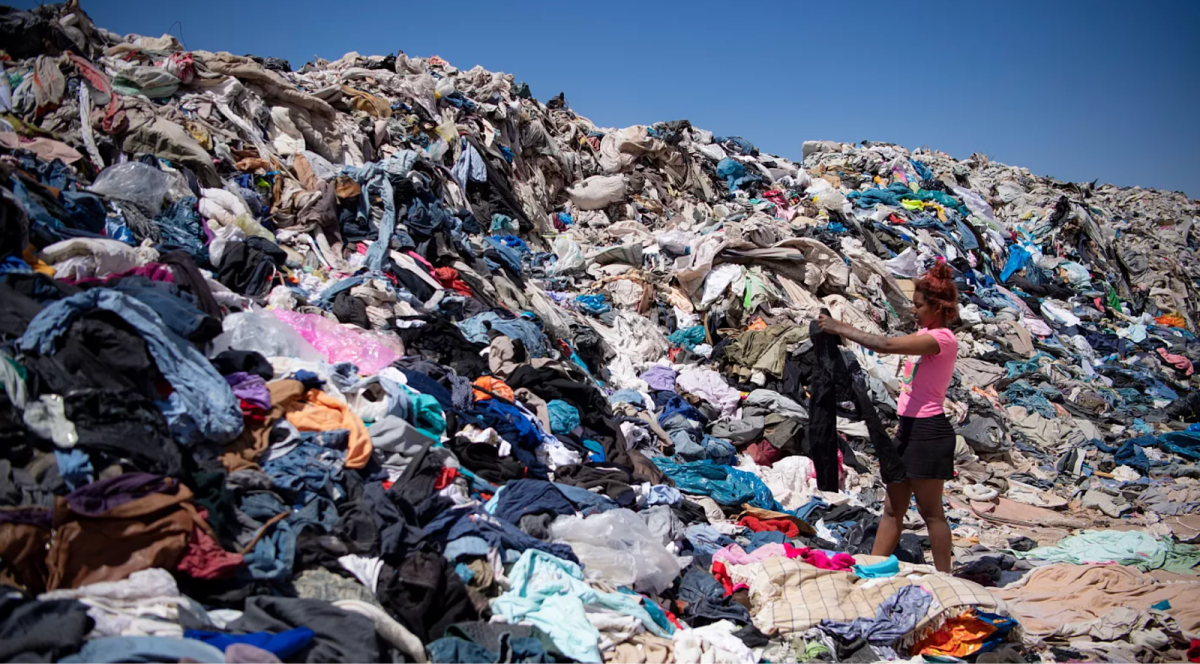In the early 1800s, new clothing was far from affordable. Without many of the advanced technologies we rely on today, garment work was labor intensive making clothing expensive. As newly made clothing was only accessible to the wealthy, those of middle and lower classes purchased more secondhand clothing.
By the early 1900s, most clothing pieces were valued at less than $10, and despite the exorbitant wealth elites during this era possessed, they didn’t own much more clothing than the working class. So how did the average person shift from buying only a few staple pieces each year to over 50 per year today?
The rise of unconscious consumerism, a phenomenon perpetuated by the capitalistic society of most of the modern world, has caused this massive growth in overconsumption. This change in consumer behavior greatly benefits large corporations, but has tremendous negative impacts on the environment and people.
Impulse purchases – unintended, unnecessary purchases – are between 40% and 80% of all purchases made by the average person, according to 1milionwomen.com. Although this number is alarming, studies show that it is not entirely the fault of the consumer. In a world where companies strive to make as much money as possible, consumers are constantly fed advertisements, promotional content, influencer brand deals and even strategic product placements to ensure that these unconscious purchases are continually made. Supermarkets are similarly structured with meat, vegetables and grains around the perimeter and a plethora of processed foods filed in rows in the middle to encourage consumers to purchase products they never intended to. The same can be said for the jewelry and other accessories placed near check-out at retail shops. The location of these items encourage purchases that may have never been made if identified anywhere else in the store.
Within the fast fashion industry, unconscious consumerism is becoming increasingly common. Think of a time when you visited a department store with the intention of window shopping and left with one or more new pieces. More often than not, these impulse buys, despite their price range, are made with cheap materials such as polyester and nylon. While you may not have kept this clothing item in your closet for more than a year, its impact on the environment can last longer than your lifetime. While sustainable fabrics like cotton and linen have the potential to decompose in a few weeks, polyester, a material often produced in fast fashion clothing due to being one of the cheapest materials available, can take anywhere from 20 to 200 years to decompose naturally. Similarly, nylon takes anywhere from 30 to 40 years to decompose.
Beyond the tremendous environmental impact, the exploitation of garment workers is another alarming consequence of unconscious consumerism and ultimately, the fast fashion industry. According to earthday.org, among the 75 million garment workers, predominantly employed in south and southeast asian countries, less than two percent make a living wage. As women make up approximately 80% of garment workers, they are subject to gender based discrimination and even harassment. Earthday.org states that large fast fashion businesses utilize unregistered vendors who don’t abide by any workplace safety or hazard prevention guidelines leading to worker’s exposure to chemicals which have been proven to cause cancer. Even worse, these workers make clothing for approximately 16 hours a day, seven days a week, leading to fatigue and long-term exposure to harmful chemicals.
These terrifying practices are all in the best interest of companies who aim to drive up profits at the expense of human rights. While many may believe these companies are few and far between, they could be amongst your favorites. Out of hundreds of others, Shein, H&M, ASOS, Gap, Old Navy, American Eagle and Nike have been accused of labour practices and negative environmental impacts.
Shein, an online megastore popular for its catalog of thousands of clothing items at unbelievably low price points, is one of the biggest offenders of human rights and environmental violations. According to Time, the facilities in which Shein’s garment workers produce clothes lack significant safety measures. According to Channel 14, these garment workers work 17 hours per day for only $20. This tremendously inadequate wage would even be reduced to $14 if any garments produced had mistakes. On top of this, Time reports that Shein emits approximately 6.3 million tons of CO2 per year.
Similarly, ASOS, another popular online label which specializes in the sale of other name brands along with its own clothing, does not pay its workers living wages. Although the brand set goals to reduce CO2 emissions and landfill waste, it has not released data pertaining to its water usage. Ultimately, ASOS lacks transparency in their labor and sustainability initiatives, which usually means the brand is not doing enough to ensure the safety and well being of their workers or the planet. Despite the limited transparency, ASOS plasters its sustainability goals on its website with limited initiatives to achieve them, a clear sign of greenwashing.
Greenwashing, as defined by Merriam-Webster is “the act or practice of making a product, policy, activity, etc. appear to be more environmentally friendly or less environmentally damaging than it really is,” is very common in current fast fashion brands. Due to the growing awareness about climate change, many large corporations tend to present their products as more sustainable as they are in reality to gain a larger consumer base and garner support from consumers, all with the aim to increase profits. This further proves that now, more than ever, it is important for buyers to be informed about the inhuman practices of fashion brands.
The principle of unconscious consumerism requires shoppers to be uninformed about unsustainable clothing materials, distressing labor conditions and company morals. While brand transparency is rare, consumers can avoid unconscious purchases of unethical brand’s products by becoming knowledgeable about how to be a conscious consumer.
Before purchasing your next clothing item, ask yourself a few questions. Do I need this item? Did I intend to purchase an item like this before I saw it? Do I already have a similar item? Do I own more than one item that can match this? Are the materials this item is made with sustainable? Do I know the labor practices and ethics of this brand?
Questions like these are crucial to think about before spending money on a product. Unsure about the ethics of a brand? Websites including GoodOnYou and Fashion Transparency Index can be valuable resources in revealing which brands care about people and the planet. Moreover, secondhand shopping, whether in person or online is guaranteed to be sustainable no matter the brand.
References
Rominger, A. (2023, July 20). The History & Rise of Fast Fashion: From the 18th Century to Today. Cory Ames. https://coryames.com/history-of-fast-fashion/
Sessions, D. L. (2023, May 3). 1910s Capsule Wardrobe & What Clothing Cost. Vintagedancer.com. https://vintagedancer.com/1900s/1910s-capsule-wardrobe-what-clothing-cost/
How many clothes are too many? (2024, May 10). PIRG. https://pirg.org/articles/how-many-clothes-are-too-many/
Unconscious Consuming: How We’re Influenced To Impulse Buy And Buy Things We Don’t Need | 1 Million Women. (2020). 1millionwomen.com.au. https://www.1millionwomen.com.au/blog/unconscious-consuming-how-were-influenced-impulse-buy-and-buy-things-we-dont-need/
Mariano, N. (2022, January 6). How Long Will It Take For Fabrics to Decompose? Cottonique – Allergy-Free Apparel. https://www.cottonique.com/blogs/articles/how-long-will-it-take-for-fabrics-to-decompose?srsltid=AfmBOoqBXPehOQ7dj5-zhHVUmPwlbqD-aUv5qf4mjO1v86IkXiSa12rm
Helm, M. (2024, September 9). Beneath the Seams: The Human Toll of Fast Fashion – Earth Day. Earth Day. https://www.earthday.org/beneath-the-seams-the-human-toll-of-fast-fashion/
Nguyen, L. (2022, October 10). The Danger of Sweatshops | Earth.org. Earth.org. https://earth.org/sweatshops/
Commons. (2021). Thecommons.earth. https://www.thecommons.earth/blog/11-surprising-fast-fashion-brands-to-avoid
How Ethical Is Nike? – Good On You. (2023, July 26). Good on You. https://goodonyou.eco/how-ethical-is-nike/
Astha Rajvanshi, Caldwell, V. J., & Johnson, A. D. (2023, January 17). Shein Is the World’s Most Popular Fashion Brand—at a Huge Cost to Us All. TIME; Time. https://time.com/6247732/shein-climate-change-labor-fashion/
Catherine. (2023, December 24). How sustainable is ASOS? Is ASOS fast fashion? Let’s discuss. Eco-Stylist. https://www.eco-stylist.com/how-sustainable-is-asos/
Merriam-Webster Dictionary. (2025, February). Merriam-Webster.com. https://www.merriam-webster.com/dictionary/greenwashing








